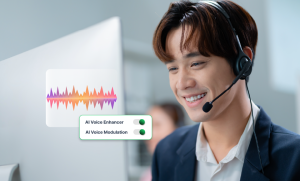Every day, global organizations lose millions due to accent-related communication friction. In contact centers, missed accents can raise Average Handle Time (AHT) by up to 40%, drop First Call Resolution (FCR) to nearly 50%, and reduce Customer Satisfaction (CSAT) scores by as much as 30%.
The problem isn’t accents themselves, but how they’re treated. For decades, companies have relied on accent neutralization, attempting to erase differences and replace them with a “standard” sound. But accents aren’t errors to fix. They are part of identity. The real solution is Accent Harmonization, which enhances clarity while preserving individuality. These AI accent localization platforms help agents communicate and being understood without losing who they are.
Why Shift from Neutralization to Harmonization?
Traditional neutralization systems convert speech to text, re-synthesize it in a “neutral” accent, and transmit it to the listener. This process introduces a latency of 500–1000ms, removes emotional tone, and produces robotic voices that undermine trust and authenticity.
AI-based accent localization takes a fundamentally different approach: it preserves the human voice while clarifying the phonemes.
Using real-time, low-latency speech-to-speech (S2S) AI, the system works directly on the audio signal. It maintains tone, pace, and vocal texture while subtly adjusting only those sound units that cause comprehension issues. The result is natural, authentic speech that sounds like the same person, only clearer.
Inside the Harmonization Engine
The quality of harmonization depends entirely on diverse, inclusive training data. To achieve real clarity, models must learn from multiple dialects, including Indian, Nigerian, Southern US, Australian, Scottish, and many more. These systems risk reinforcing stereotypes without solving communication gaps.
Once trained, the AI follows a three-step pipeline:
- Analysis – Maps phonemes, rhythm, and intonation while recognizing speaker identity and listener context.
- Adaptation – Adjusts only confusing phonemes with surgical precision, keeping tone and emotion intact.
- Synthesis – Reconstructs speech with these refined sounds, maintaining the speaker’s unique voice and warmth.
Eliminating Bias with AI-powered Accent Harmonizer
Legacy voice technologies often carry built-in bias. Traditional ASR systems record 2–3x higher error rates for non-standard accents, leading to unfair evaluations. Speech AI for accent correction aims to break that cycle through four key principles:
- Data Inclusivity – Training datasets must represent global accents across geography, gender, age, and socioeconomic background, with no group underrepresented.
- Agent Autonomy – Harmonization should be optional. Agents control when and how much harmonization to use without penalties.
- Familiar, not “Superior” Dialects – The goal isn’t to mimic “American” or “British” English, but to harmonize toward what sounds familiar to the listener, depending on the call context.
- Transparency – Stakeholders should understand when harmonization is active, how data is handled, and what the ethical safeguards are.
When applied responsibly, harmonization amplifies fairness and empathy.
The ROI of Measurable Impact Across Industries
Enterprises working with an AI-powered accent harmonizer are seeing both financial and human benefits.
Customer Experience (CX) Gains
- CSAT scores rise by 18–25 points
- NPS improves 12–20 points
- “Ease of understanding” ratings jump by up to 50%
- FCR improves from 55% to 70–75%, while AHT drops by up to 25%
Agent Experience (EX) Improvements
- 67% report lower communication anxiety
- 54% see higher job satisfaction
- Burnout-related absences fall by over 40%
When agents no longer fight to be understood, they can focus on empathy, accuracy, and resolution—the real drivers of service quality.
Operational and Cost Benefits
- Access to global talent without accent bias
- Elimination of $2K–$5K accent training per agent
- Lower turnover and 30–40% fewer repeat calls
Where It Matters Most
- Contact Centers: Quickest ROI in measurable KPIs
- Telehealth: Clear speech improves safety and compliance
- Financial Services: Enhanced clarity builds customer trust
- Technical Support: Better comprehension in high-stress calls
The Future: From Harmonization to Hyper-Personalization
Today’s harmonization focuses on clarity and comprehension; tomorrow’s will tune into context, emotion, and region.
Next-generation systems will enable hyper-local adaptation depending on the listener’s accent familiarity. Beyond clarity, the AI-powered accent harmonizer adjusts tone in real time:
- Soften your voice and warmth for frustrated customers
- Match urgency or calmness to emotional state
- Shift formality based on conversation type
Ultimately, these systems will unify voice identity across channels, calls, video, voicebots, and virtual agents. They create a consistent and humanized voice experience across every interaction.
Conclusion: The Human Future of Voice AI
Accent harmonization redefines clarity and identity so that they don’t compete with each other. It tries to standardize voices in the name of clarity. Now, AI gives us the power to do something profoundly better: make every voice understandable without making anyone identical.
AI accent localization enables every speaker to be understood and authentic at once. The real-time speech-to-speech AI has proven it can deliver clarity without latency or loss of emotion. Also, harmonization restores fairness where accent bias once excluded talent. It improves CX metrics, agent morale, and global scalability.
Ready to explore our Accent Harmonizer to transform your customer and agent experience? Fill the contact form to schedule a demo.























